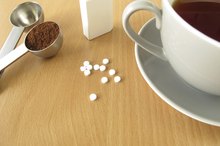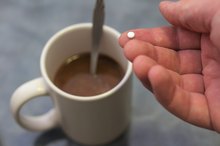Side Effects of Sodium Cyclamate
Sodium cyclamate is an artificial sweetener that's 30 times as sweet as sugar. The U.S. Food and Drug Administration banned it in 1969 due to concerns about its safety after an animal study showed a potential increased risk for cancer. The FDA has yet to overturn this ban in spite of more recent research not showing this same risk, at least in part due to problems in determining a safe intake level.
Use in Foods
While cyclamate isn't allowed in the United States, Japan and 45 other countries, it is permitted in more than 80 countries, including European Union members. It's sometimes combined with saccharin in a 10-to-1 ratio to get the best of both sweeteners -- saccharin because of its extreme sweetness and cyclamate because it has a more natural taste than saccharin and doesn't have as much of an aftertaste. It's used in artificially sweetened beverages, including those that are water-based, milk-based and fruit-juice-based.
Cancer Risk
Canderel Side Effects
Learn More
In 1969, a study found that a cyclamate-saccharin mixture caused bladder cancer in rats, but since then numerous studies have shown no link between cyclamate and cancer, according to a review article published in Food & Nutrition Research in 2006. For example, a study published in Toxicological Sciences in 2000 found that high doses of cyclamate didn't increase cancer risk or have toxic effects in monkeys. The National Cancer Institute notes that the FDA's current concerns about this sweetener are not related to cancer.
Effect on Male Fertility
Although there's some concern about the risk of cyclamate affecting male fertility due to the results of certain animal studies, a study published in 2003 in Food Additives & Contaminants didn't find any effect of cyclamate on male fertility at the levels usually consumed by people in Spain, where this sweetener is legal. This concern came about after a study showed that cyclohexylamine, which is produced when cyclamate is metabolized, could cause testicular atrophy in rats.
Intake Considerations
Possible Side Effects of Maltodextrin and Sucralose
Learn More
The European Union has set the acceptable intake level for cyclamate at 0 to 7 milligrams per kilogram of body weight, or between 0 and 3 milligrams per pound of body weight. The problem with cyclamate is that although most people don't metabolize or absorb it, some people do metabolize it, and this variation makes it hard to determine what levels are safe for everyone. Drinking 1.5 liters of soda sweetened with cyclamate can cause people to reach the acceptable intake level set by the European Union.
Related Articles
References
- U.S. Food and Drug Administration: Cyclamate and Its Derivatives
- Toxicological Sciences: Long-Term Toxicity and Carcinogenicity Study of Cyclamate in Nonhuman Primates
- National Cancer Institute: Artificial Sweeteners and Cancer
- Food Additives & Contaminants: Cyclamate Intake and Cyclohexylamine Excretion Are Not Related to Male Fertility in Humans
- Cereals & Oils: Food Additives Monitoring Hot Spots and Investigate the Safety of Sodium Cyclamate
- Time: Are Artificial Sweeteners Really That Bad for You?
Writer Bio
Based in Massachusetts, Jessica Bruso has been writing since 2008. She holds a master of science degree in food policy and applied nutrition and a bachelor of arts degree in international relations, both from Tufts University.









